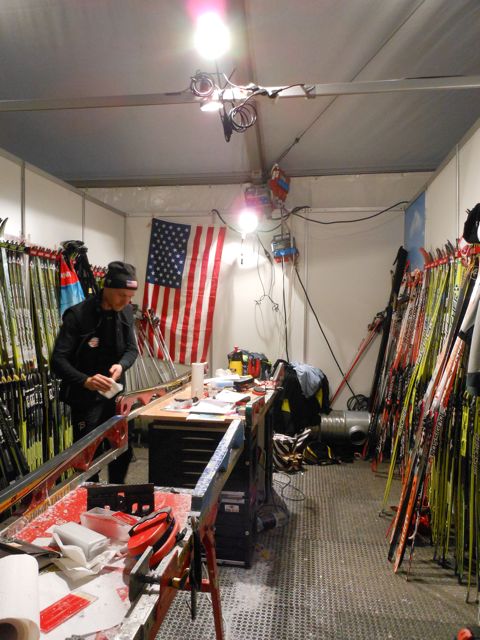
The health effects of airborne particles from ski waxing is a hot topic – and the more expensive and fluorinated the wax, the worse the health effects are.
Just ask the U.S. Ski Team, which two years ago raised a fuss at the Davos, Switzerland, World Cup, where there is no ventilation system in the common waxing tent shared by all the teams.
“They put up a huge tent with very little ventilation,” Noah Hoffman wrote on his blog in 2013. “All of the air is communal so as soon as one team starts burning fluoro-powders, the air is bad for everyone. This poses a huge health risk for the wax techs and is a major reason many of the wealthy teams have gotten wax trucks. The techs and athletes have complained about the Davos setup for years and nothing has been done to address the problem. Some athletes are talking about boycotting venues that don’t address technician health.”
But how many of these particles, also called inhaled aerosol fractions, are wax techs actually exposed to? And what are the implications for racers who wax their own skis, or waxers who work in a ski shop, for instance?
That’s the topic of a recent study in the journal Annals of Occupational Hygiene. And it’s published by researchers at Norway’s National Institute of Occupational Health – of course, because Norway is perhaps the only country where being a wax tech is a widespread enough occupation to merit government investigation.
Dr. Baard Ingegerdsson Freberg and six other authors write that “Ski waxing cabins used during World Cup competitions most often have no ventilation system, or at best limited general ventilation systems…. Also the time pressure and the stressful working conditions for the ski waxers reduce the potential for preventive actions and exposure control.”
To assess the amount of inhaled aerosol fractions, the team used size-selective aerosol samplers attached to a belt so that the air sampled would actually be in the area that the wax techs were breathing from. Furthermore, they used two different filters: one for inhalable particles (100 microns or smaller in size), and one for respirable particles (10 microns or smaller).
They convinced 45 different wax techs to participate in the study, sampling for the duration of a waxing session – which lasted from as short as half an hour to a full eight-hour day. The wax techs all worked for different international ski teams, and data was collected at six different race weekends in Oslo, Trondheim, and Beitostølen, Norway.
They found average exposures of 3.1 mg·m−3 and 6.2 mg·m−3 to respirable and inhalable aerosols, respectively. What does that mean? There’s no set occupational exposure limit for ski wax fumes, but a comparable hazard might be paraffin wax fumes. In Norway, the maximum exposure limit for that is 2 mg·m−3 in the inhalable aerosol mass fraction.
The average inhalable aerosol fraction for the wax techs was about three times that – not a good sign. It explains why wax techs have reported respiratory problems or even long-term issues with lung function.
Still, those numbers might not mean much to anyone other than a chemist, but there were also some interesting patterns: over the course of a work day, there were peaks in exposure, generally occurring just before the start of a race.
And biathlon and Nordic combined wax techs were exposed to much higher concentrations than cross country ski wax techs, perhaps because classic kick wax does not produce as many aerosols.
Together, these patterns suggest that if there’s ever a time to wear a good respirator, it’s when the powders are flying in the final push to get skate skis to the start line.
(A previous study by the same team found that applying powders was the most hazardous work task for wax techs in terms of chemical exposure, although using solvent to remove kickwax wasn’t so great, either.)
What’s a better solution? An effective ventilation system which would make waxers less reliant on respirators, which may be uncomfortable and limit communication between different members of the ski prep team.
The research team built its own custom-made ventilation hood which covers the whole length of a ski, and compared the exposure to aerosols with and without the hood when preparing a series of 15 pairs of skis. The system did succeed in reducing exposure by 95% when using fluoro powders, and by 88-92% when using block glidewax.
Here’s hoping that a system like this begins to make its way into wax cabins and tents at the World Cup and many other levels of competition.
Chelsea Little
Chelsea Little is FasterSkier's Editor-At-Large. A former racer at Ford Sayre, Dartmouth College and the Craftsbury Green Racing Project, she is a PhD candidate in aquatic ecology in the @Altermatt_lab at Eawag, the Swiss Federal Institute of Aquatic Science and Technology in Zurich, Switzerland. You can follow her on twitter @ChelskiLittle.




2 comments
nordicmatt
September 26, 2014 at 12:30 pm
Actually, even a chemist could care less about the sampling results. Now an occupational toxicologist, they may sit-up and take notice that “Dose makes the poison!” I remember another study was conducted on wax techs; in which several of them were smokers. Interesting to see if any of the current techs are smokers. I addressed the topic of wax room exposures when I put together an article back in early 2000/01 and I still think it is posted on the internet because I still get inquiries and I answer them as I can. The impetus for that was a response to a US Nordic shop advertisement that was selling respirators as the “most popular on the World Cup circuit!” The article is not comprehensive, but understandable. Probably could use an update as well. I think having a MS degree in Industrial Hygiene and being a Certified Industrial Hygienist (kind of like a PE for occupational exposures to chemicals, physical hazards-noise, radiation, vibration) lets me speak a bit on the topic. Ms. Little touches on the use of respiratory protection which is actually the last choice when considering the hierarchy of controls. In many workplaces I go to, respirators are the most abused pieces of personal protective equipment. Most male wax techs I run into are generally not clean shaven. You can forget about any tight-fitting respirator offering the protection it prescribes when facial hair exists. A powered air-purifying (PAPR) loose fitting hood may be the better option. Engineering controls such as ventilation is going to offer the greatest protection as indicated in this article. I would go a step further and use a local exhaust system versus a capture hood which seems to be described here. I have rigged up a local exhaust in my garage in which the capture hood is attached to the wax iron via a flexible two inch duct. Does great on the wax fume but does nothing for the particulate. Any additional ventilation system design would need some type of cyclone to spin out the big particulate for disposal.
The cool thing is as I write this, the FasterSkier photo backdrop is that of the US nationals 50k classic and I see a lot of great skiers in the tracks I put in up on the Anchorage Hillside!
Jon Fewster
October 3, 2014 at 5:45 pm
Nordicmatt and others – would it be possible for you to post pictures of your setup? I would like to build something for my waxbench and would appreciate seeing what you have built. Thanks!